Breaching of Nursing Practice: Ethical and Legal Implications Analysis
VerifiedAdded on 2023/04/22
|8
|1745
|225
Essay
AI Summary
This essay examines the breaching of nursing practice through two detailed incident case studies. The analysis highlights violations of Nursing and Midwifery Board of Australia (NMBA) standards, clinical governance principles, cultural safety protocols, and relevant laws and ethics. The incidents involve...
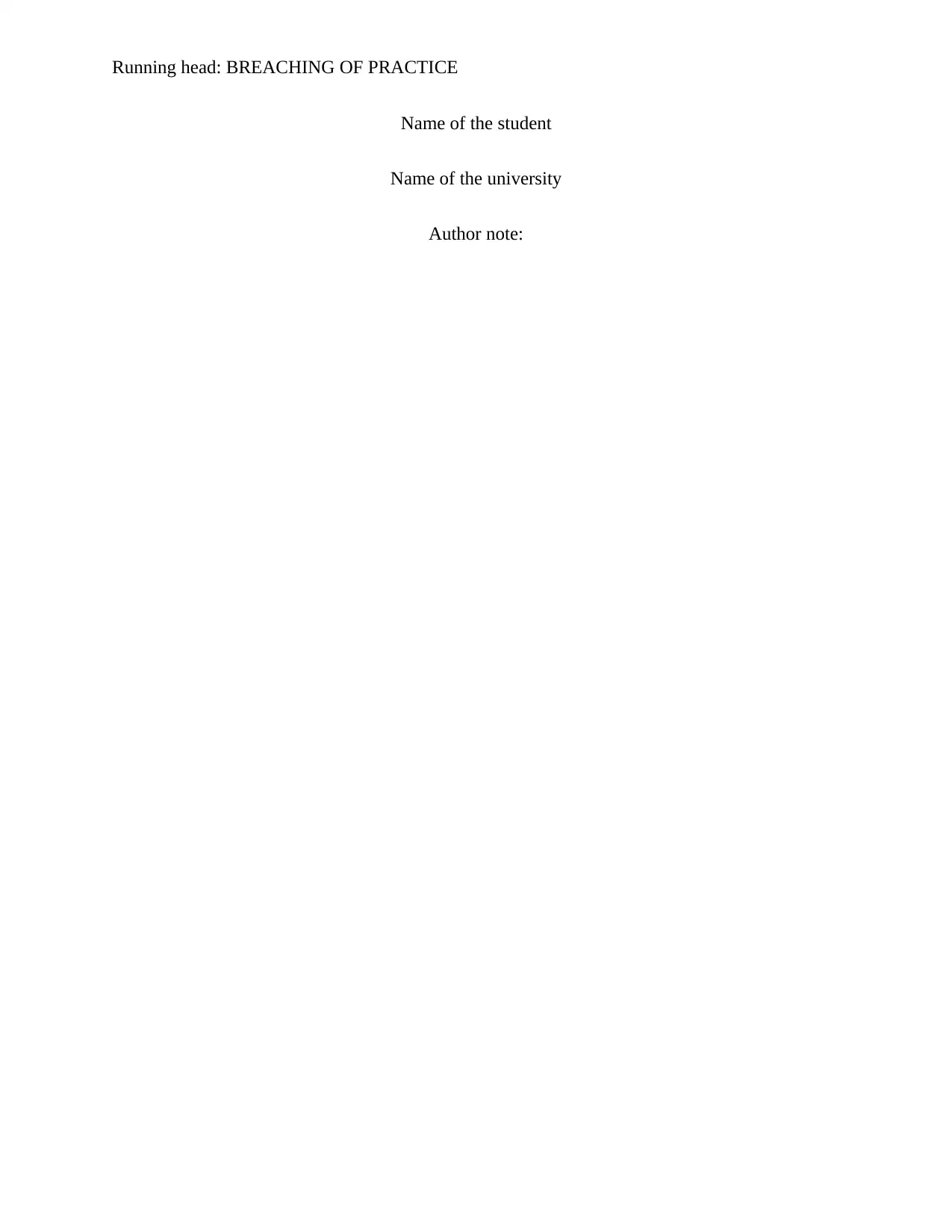
Running head: BREACHING OF PRACTICE
Name of the student
Name of the university
Author note:
Name of the student
Name of the university
Author note:
Paraphrase This Document
Need a fresh take? Get an instant paraphrase of this document with our AI Paraphraser
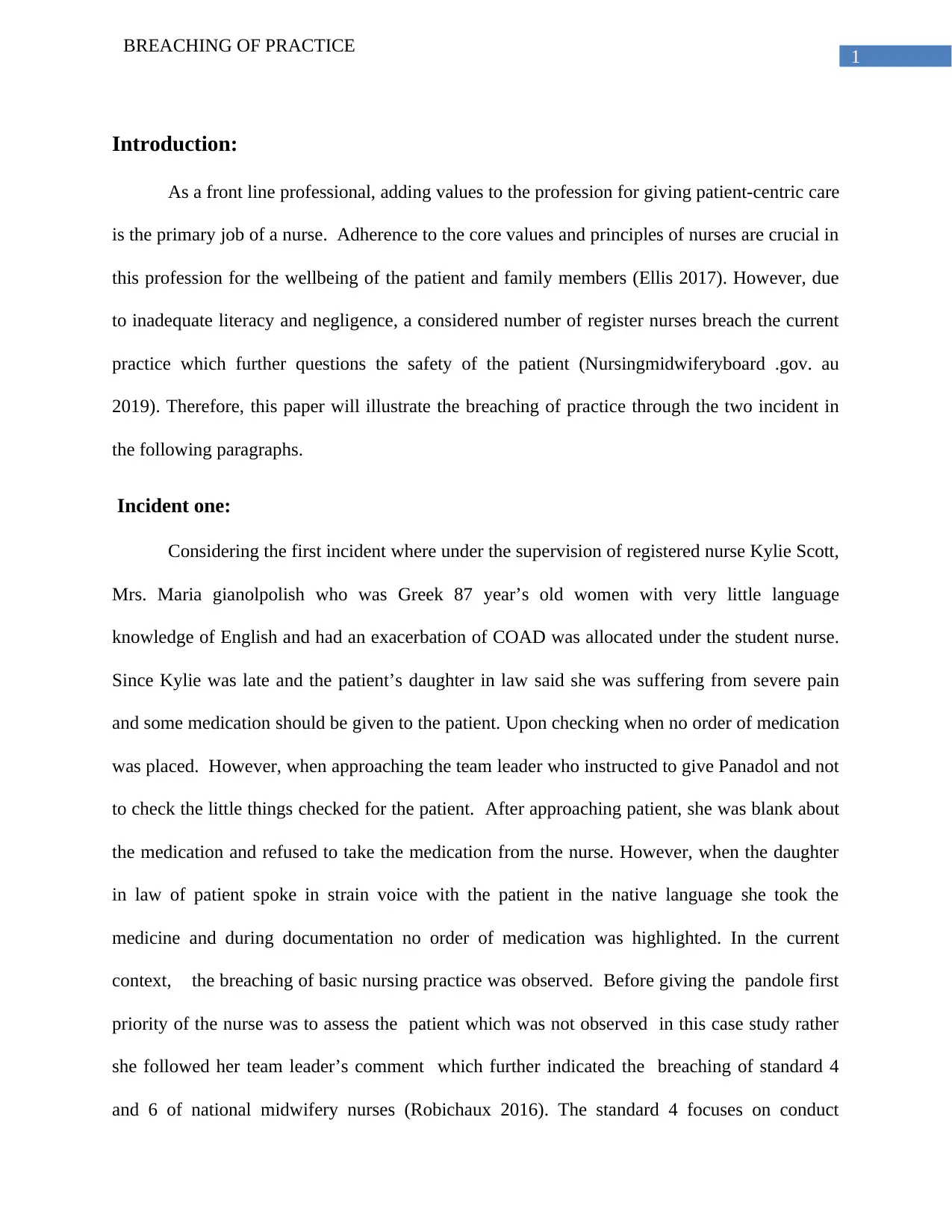
1
BREACHING OF PRACTICE
Introduction:
As a front line professional, adding values to the profession for giving patient-centric care
is the primary job of a nurse. Adherence to the core values and principles of nurses are crucial in
this profession for the wellbeing of the patient and family members (Ellis 2017). However, due
to inadequate literacy and negligence, a considered number of register nurses breach the current
practice which further questions the safety of the patient (Nursingmidwiferyboard .gov. au
2019). Therefore, this paper will illustrate the breaching of practice through the two incident in
the following paragraphs.
Incident one:
Considering the first incident where under the supervision of registered nurse Kylie Scott,
Mrs. Maria gianolpolish who was Greek 87 year’s old women with very little language
knowledge of English and had an exacerbation of COAD was allocated under the student nurse.
Since Kylie was late and the patient’s daughter in law said she was suffering from severe pain
and some medication should be given to the patient. Upon checking when no order of medication
was placed. However, when approaching the team leader who instructed to give Panadol and not
to check the little things checked for the patient. After approaching patient, she was blank about
the medication and refused to take the medication from the nurse. However, when the daughter
in law of patient spoke in strain voice with the patient in the native language she took the
medicine and during documentation no order of medication was highlighted. In the current
context, the breaching of basic nursing practice was observed. Before giving the pandole first
priority of the nurse was to assess the patient which was not observed in this case study rather
she followed her team leader’s comment which further indicated the breaching of standard 4
and 6 of national midwifery nurses (Robichaux 2016). The standard 4 focuses on conduct
BREACHING OF PRACTICE
Introduction:
As a front line professional, adding values to the profession for giving patient-centric care
is the primary job of a nurse. Adherence to the core values and principles of nurses are crucial in
this profession for the wellbeing of the patient and family members (Ellis 2017). However, due
to inadequate literacy and negligence, a considered number of register nurses breach the current
practice which further questions the safety of the patient (Nursingmidwiferyboard .gov. au
2019). Therefore, this paper will illustrate the breaching of practice through the two incident in
the following paragraphs.
Incident one:
Considering the first incident where under the supervision of registered nurse Kylie Scott,
Mrs. Maria gianolpolish who was Greek 87 year’s old women with very little language
knowledge of English and had an exacerbation of COAD was allocated under the student nurse.
Since Kylie was late and the patient’s daughter in law said she was suffering from severe pain
and some medication should be given to the patient. Upon checking when no order of medication
was placed. However, when approaching the team leader who instructed to give Panadol and not
to check the little things checked for the patient. After approaching patient, she was blank about
the medication and refused to take the medication from the nurse. However, when the daughter
in law of patient spoke in strain voice with the patient in the native language she took the
medicine and during documentation no order of medication was highlighted. In the current
context, the breaching of basic nursing practice was observed. Before giving the pandole first
priority of the nurse was to assess the patient which was not observed in this case study rather
she followed her team leader’s comment which further indicated the breaching of standard 4
and 6 of national midwifery nurses (Robichaux 2016). The standard 4 focuses on conduct
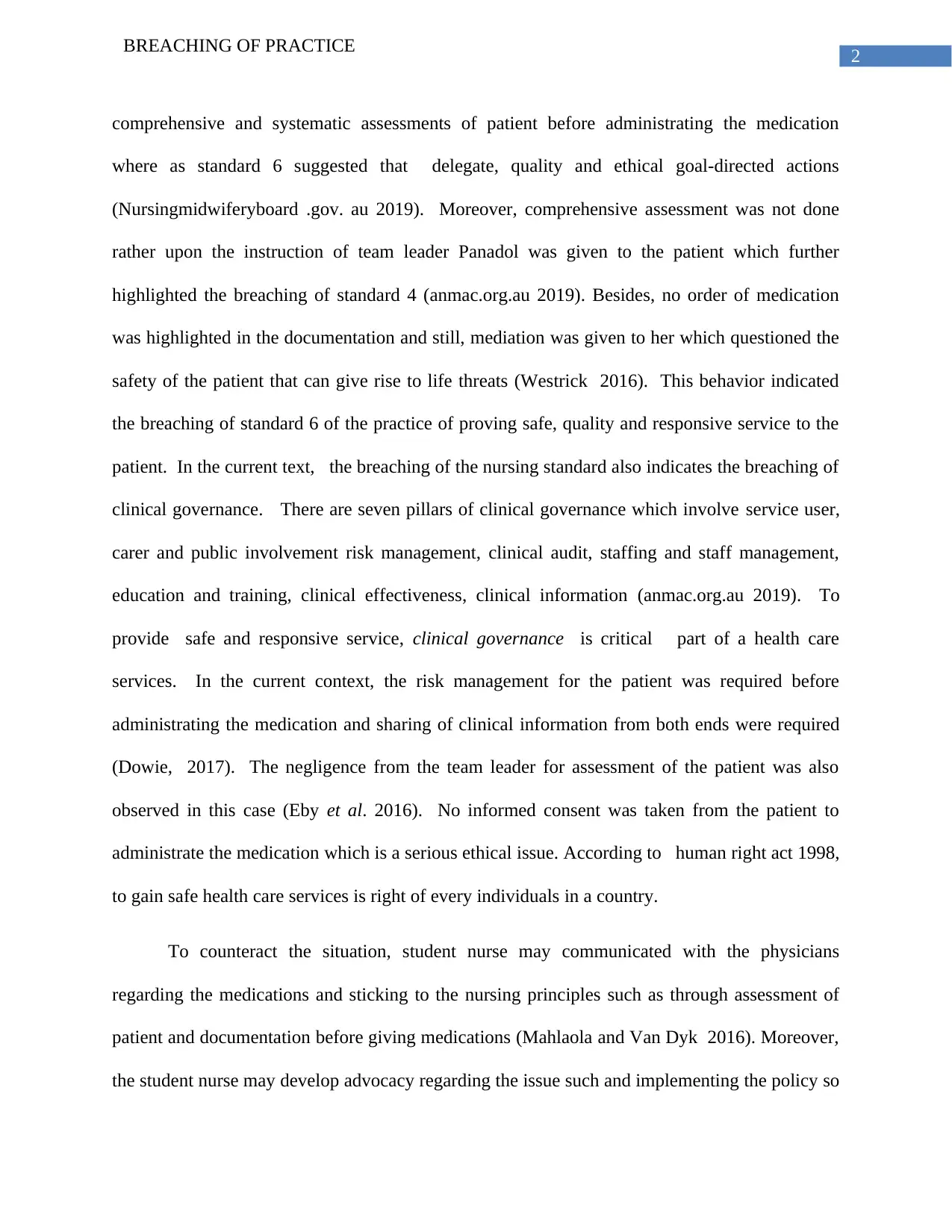
2
BREACHING OF PRACTICE
comprehensive and systematic assessments of patient before administrating the medication
where as standard 6 suggested that delegate, quality and ethical goal-directed actions
(Nursingmidwiferyboard .gov. au 2019). Moreover, comprehensive assessment was not done
rather upon the instruction of team leader Panadol was given to the patient which further
highlighted the breaching of standard 4 (anmac.org.au 2019). Besides, no order of medication
was highlighted in the documentation and still, mediation was given to her which questioned the
safety of the patient that can give rise to life threats (Westrick 2016). This behavior indicated
the breaching of standard 6 of the practice of proving safe, quality and responsive service to the
patient. In the current text, the breaching of the nursing standard also indicates the breaching of
clinical governance. There are seven pillars of clinical governance which involve service user,
carer and public involvement risk management, clinical audit, staffing and staff management,
education and training, clinical effectiveness, clinical information (anmac.org.au 2019). To
provide safe and responsive service, clinical governance is critical part of a health care
services. In the current context, the risk management for the patient was required before
administrating the medication and sharing of clinical information from both ends were required
(Dowie, 2017). The negligence from the team leader for assessment of the patient was also
observed in this case (Eby et al. 2016). No informed consent was taken from the patient to
administrate the medication which is a serious ethical issue. According to human right act 1998,
to gain safe health care services is right of every individuals in a country.
To counteract the situation, student nurse may communicated with the physicians
regarding the medications and sticking to the nursing principles such as through assessment of
patient and documentation before giving medications (Mahlaola and Van Dyk 2016). Moreover,
the student nurse may develop advocacy regarding the issue such and implementing the policy so
BREACHING OF PRACTICE
comprehensive and systematic assessments of patient before administrating the medication
where as standard 6 suggested that delegate, quality and ethical goal-directed actions
(Nursingmidwiferyboard .gov. au 2019). Moreover, comprehensive assessment was not done
rather upon the instruction of team leader Panadol was given to the patient which further
highlighted the breaching of standard 4 (anmac.org.au 2019). Besides, no order of medication
was highlighted in the documentation and still, mediation was given to her which questioned the
safety of the patient that can give rise to life threats (Westrick 2016). This behavior indicated
the breaching of standard 6 of the practice of proving safe, quality and responsive service to the
patient. In the current text, the breaching of the nursing standard also indicates the breaching of
clinical governance. There are seven pillars of clinical governance which involve service user,
carer and public involvement risk management, clinical audit, staffing and staff management,
education and training, clinical effectiveness, clinical information (anmac.org.au 2019). To
provide safe and responsive service, clinical governance is critical part of a health care
services. In the current context, the risk management for the patient was required before
administrating the medication and sharing of clinical information from both ends were required
(Dowie, 2017). The negligence from the team leader for assessment of the patient was also
observed in this case (Eby et al. 2016). No informed consent was taken from the patient to
administrate the medication which is a serious ethical issue. According to human right act 1998,
to gain safe health care services is right of every individuals in a country.
To counteract the situation, student nurse may communicated with the physicians
regarding the medications and sticking to the nursing principles such as through assessment of
patient and documentation before giving medications (Mahlaola and Van Dyk 2016). Moreover,
the student nurse may develop advocacy regarding the issue such and implementing the policy so
⊘ This is a preview!⊘
Do you want full access?
Subscribe today to unlock all pages.

Trusted by 1+ million students worldwide
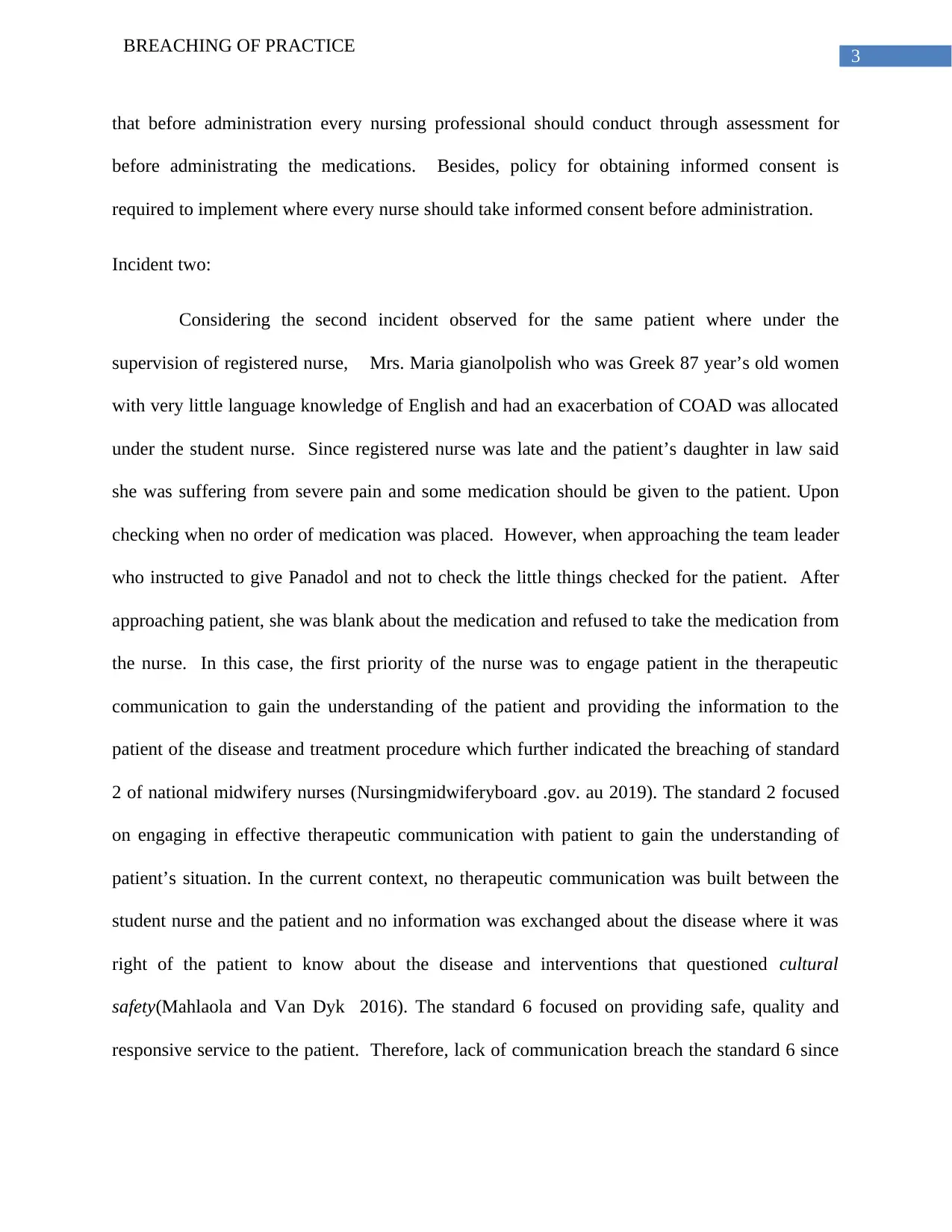
3
BREACHING OF PRACTICE
that before administration every nursing professional should conduct through assessment for
before administrating the medications. Besides, policy for obtaining informed consent is
required to implement where every nurse should take informed consent before administration.
Incident two:
Considering the second incident observed for the same patient where under the
supervision of registered nurse, Mrs. Maria gianolpolish who was Greek 87 year’s old women
with very little language knowledge of English and had an exacerbation of COAD was allocated
under the student nurse. Since registered nurse was late and the patient’s daughter in law said
she was suffering from severe pain and some medication should be given to the patient. Upon
checking when no order of medication was placed. However, when approaching the team leader
who instructed to give Panadol and not to check the little things checked for the patient. After
approaching patient, she was blank about the medication and refused to take the medication from
the nurse. In this case, the first priority of the nurse was to engage patient in the therapeutic
communication to gain the understanding of the patient and providing the information to the
patient of the disease and treatment procedure which further indicated the breaching of standard
2 of national midwifery nurses (Nursingmidwiferyboard .gov. au 2019). The standard 2 focused
on engaging in effective therapeutic communication with patient to gain the understanding of
patient’s situation. In the current context, no therapeutic communication was built between the
student nurse and the patient and no information was exchanged about the disease where it was
right of the patient to know about the disease and interventions that questioned cultural
safety(Mahlaola and Van Dyk 2016). The standard 6 focused on providing safe, quality and
responsive service to the patient. Therefore, lack of communication breach the standard 6 since
BREACHING OF PRACTICE
that before administration every nursing professional should conduct through assessment for
before administrating the medications. Besides, policy for obtaining informed consent is
required to implement where every nurse should take informed consent before administration.
Incident two:
Considering the second incident observed for the same patient where under the
supervision of registered nurse, Mrs. Maria gianolpolish who was Greek 87 year’s old women
with very little language knowledge of English and had an exacerbation of COAD was allocated
under the student nurse. Since registered nurse was late and the patient’s daughter in law said
she was suffering from severe pain and some medication should be given to the patient. Upon
checking when no order of medication was placed. However, when approaching the team leader
who instructed to give Panadol and not to check the little things checked for the patient. After
approaching patient, she was blank about the medication and refused to take the medication from
the nurse. In this case, the first priority of the nurse was to engage patient in the therapeutic
communication to gain the understanding of the patient and providing the information to the
patient of the disease and treatment procedure which further indicated the breaching of standard
2 of national midwifery nurses (Nursingmidwiferyboard .gov. au 2019). The standard 2 focused
on engaging in effective therapeutic communication with patient to gain the understanding of
patient’s situation. In the current context, no therapeutic communication was built between the
student nurse and the patient and no information was exchanged about the disease where it was
right of the patient to know about the disease and interventions that questioned cultural
safety(Mahlaola and Van Dyk 2016). The standard 6 focused on providing safe, quality and
responsive service to the patient. Therefore, lack of communication breach the standard 6 since
Paraphrase This Document
Need a fresh take? Get an instant paraphrase of this document with our AI Paraphraser

4
BREACHING OF PRACTICE
communicating with patient would give the idea of cultural values and beliefs which could be
incorporated in the service for giving a sense of comfort(Nursingmidwiferyboard .gov. au 2019)
To counteract the situation, the student nurse may communicate with the patient with the
assistance of daughter in law to gain the concern of patient or request for translator to resolve
language barriers. It would give the patient a sense of comfort and develop therapeutic
communication between them. Moreover, the student nurse may communicate with the
authorities to incorporate culturally safe and competent services in the hospital policy otherwise
it would question the safety of patient.
Conclusion:
On a concluding note, breaching of nursing practice is a critical ethical issue which
affected the patient outcome and satisfaction. In the paper, two incidents were highlighted where
breaching of nursing practice was observed. The case study highlighted the breaching of NMBA
standard, clinical governance along with cultural safety and laws and ethics during encounters.
These two case studies influenced gain the understanding of nursing practice such as building
therapeutic communication with the patient, providing information to the patient, conducting
clinical assessment and providing safe care to the patient. Moreover, the case study gains to the
understanding of the cultural safety and language barriers which are required to incorporate in
the nursing practice. Moreover, these two incidents, influenced the practice as a nursing student
to gain the understanding of Nurse Practitioner Accreditation Standards such as building
advocacy for incorporating cultural safety in the hospital policy, assessing the credentials as a
nurse by participating in the workshops, improving quality of the care and assessment of risk of
medications and interventions for patient and evaluating outcome of patient. These standards
BREACHING OF PRACTICE
communicating with patient would give the idea of cultural values and beliefs which could be
incorporated in the service for giving a sense of comfort(Nursingmidwiferyboard .gov. au 2019)
To counteract the situation, the student nurse may communicate with the patient with the
assistance of daughter in law to gain the concern of patient or request for translator to resolve
language barriers. It would give the patient a sense of comfort and develop therapeutic
communication between them. Moreover, the student nurse may communicate with the
authorities to incorporate culturally safe and competent services in the hospital policy otherwise
it would question the safety of patient.
Conclusion:
On a concluding note, breaching of nursing practice is a critical ethical issue which
affected the patient outcome and satisfaction. In the paper, two incidents were highlighted where
breaching of nursing practice was observed. The case study highlighted the breaching of NMBA
standard, clinical governance along with cultural safety and laws and ethics during encounters.
These two case studies influenced gain the understanding of nursing practice such as building
therapeutic communication with the patient, providing information to the patient, conducting
clinical assessment and providing safe care to the patient. Moreover, the case study gains to the
understanding of the cultural safety and language barriers which are required to incorporate in
the nursing practice. Moreover, these two incidents, influenced the practice as a nursing student
to gain the understanding of Nurse Practitioner Accreditation Standards such as building
advocacy for incorporating cultural safety in the hospital policy, assessing the credentials as a
nurse by participating in the workshops, improving quality of the care and assessment of risk of
medications and interventions for patient and evaluating outcome of patient. These standards
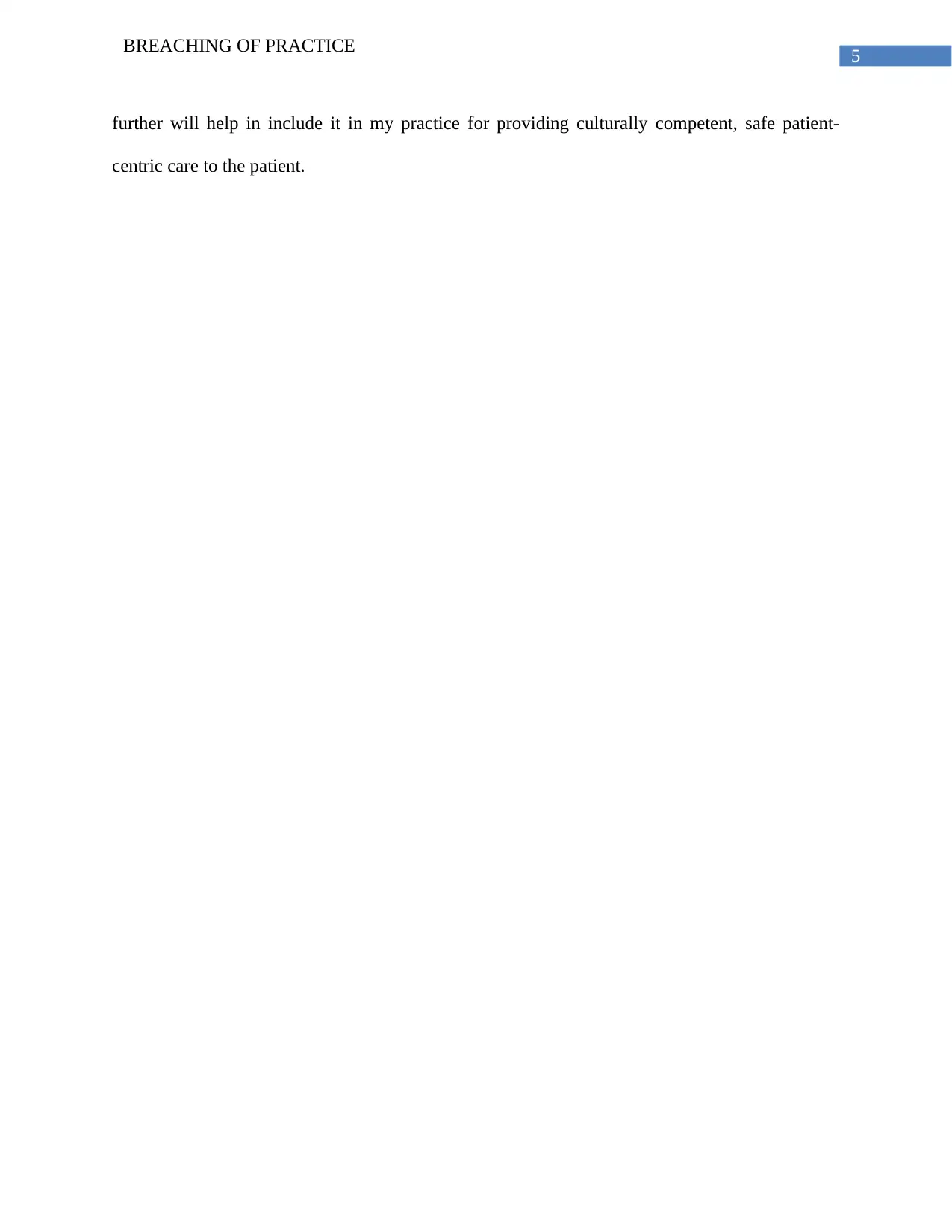
5
BREACHING OF PRACTICE
further will help in include it in my practice for providing culturally competent, safe patient-
centric care to the patient.
BREACHING OF PRACTICE
further will help in include it in my practice for providing culturally competent, safe patient-
centric care to the patient.
⊘ This is a preview!⊘
Do you want full access?
Subscribe today to unlock all pages.

Trusted by 1+ million students worldwide
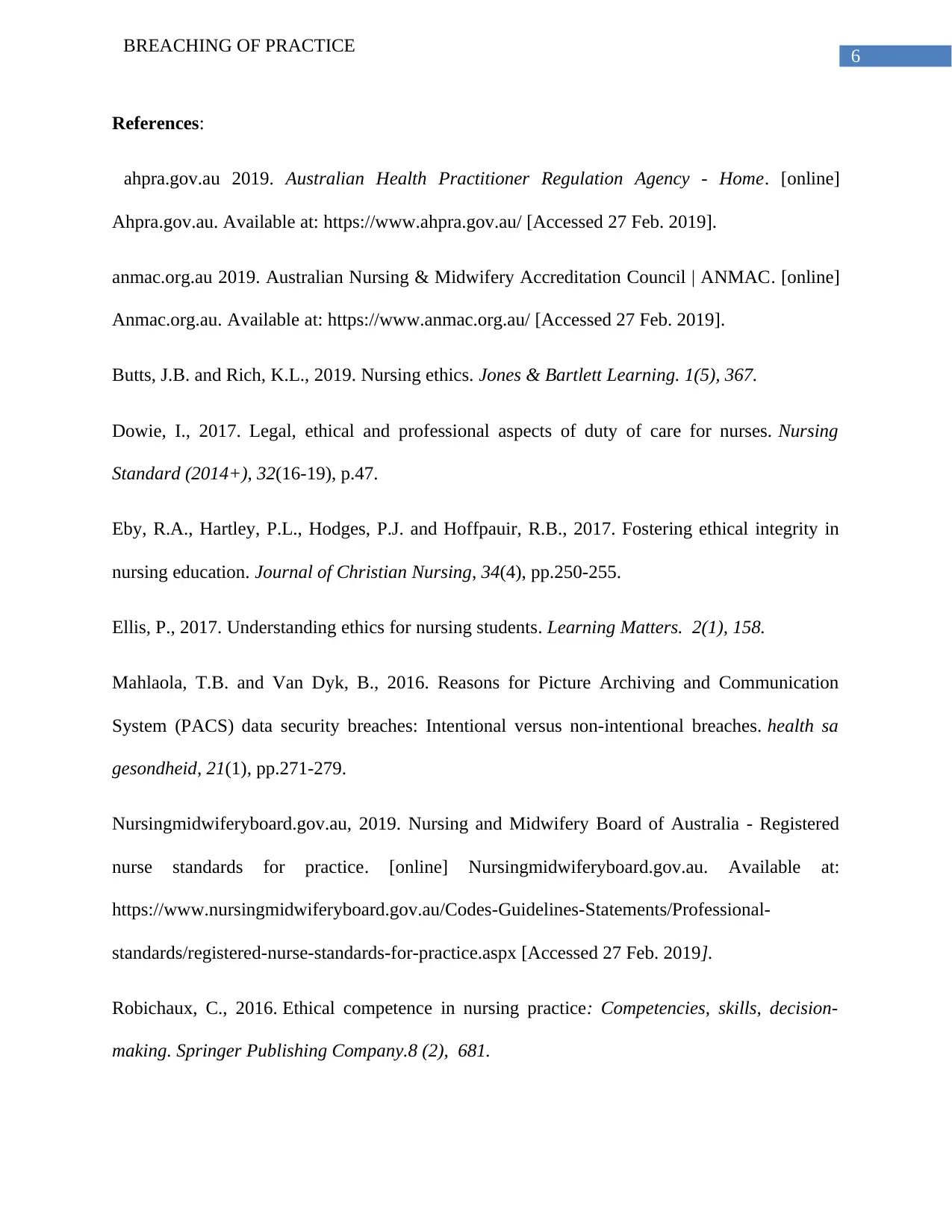
6
BREACHING OF PRACTICE
References:
ahpra.gov.au 2019. Australian Health Practitioner Regulation Agency - Home. [online]
Ahpra.gov.au. Available at: https://www.ahpra.gov.au/ [Accessed 27 Feb. 2019].
anmac.org.au 2019. Australian Nursing & Midwifery Accreditation Council | ANMAC. [online]
Anmac.org.au. Available at: https://www.anmac.org.au/ [Accessed 27 Feb. 2019].
Butts, J.B. and Rich, K.L., 2019. Nursing ethics. Jones & Bartlett Learning. 1(5), 367.
Dowie, I., 2017. Legal, ethical and professional aspects of duty of care for nurses. Nursing
Standard (2014+), 32(16-19), p.47.
Eby, R.A., Hartley, P.L., Hodges, P.J. and Hoffpauir, R.B., 2017. Fostering ethical integrity in
nursing education. Journal of Christian Nursing, 34(4), pp.250-255.
Ellis, P., 2017. Understanding ethics for nursing students. Learning Matters. 2(1), 158.
Mahlaola, T.B. and Van Dyk, B., 2016. Reasons for Picture Archiving and Communication
System (PACS) data security breaches: Intentional versus non-intentional breaches. health sa
gesondheid, 21(1), pp.271-279.
Nursingmidwiferyboard.gov.au, 2019. Nursing and Midwifery Board of Australia - Registered
nurse standards for practice. [online] Nursingmidwiferyboard.gov.au. Available at:
https://www.nursingmidwiferyboard.gov.au/Codes-Guidelines-Statements/Professional-
standards/registered-nurse-standards-for-practice.aspx [Accessed 27 Feb. 2019].
Robichaux, C., 2016. Ethical competence in nursing practice: Competencies, skills, decision-
making. Springer Publishing Company.8 (2), 681.
BREACHING OF PRACTICE
References:
ahpra.gov.au 2019. Australian Health Practitioner Regulation Agency - Home. [online]
Ahpra.gov.au. Available at: https://www.ahpra.gov.au/ [Accessed 27 Feb. 2019].
anmac.org.au 2019. Australian Nursing & Midwifery Accreditation Council | ANMAC. [online]
Anmac.org.au. Available at: https://www.anmac.org.au/ [Accessed 27 Feb. 2019].
Butts, J.B. and Rich, K.L., 2019. Nursing ethics. Jones & Bartlett Learning. 1(5), 367.
Dowie, I., 2017. Legal, ethical and professional aspects of duty of care for nurses. Nursing
Standard (2014+), 32(16-19), p.47.
Eby, R.A., Hartley, P.L., Hodges, P.J. and Hoffpauir, R.B., 2017. Fostering ethical integrity in
nursing education. Journal of Christian Nursing, 34(4), pp.250-255.
Ellis, P., 2017. Understanding ethics for nursing students. Learning Matters. 2(1), 158.
Mahlaola, T.B. and Van Dyk, B., 2016. Reasons for Picture Archiving and Communication
System (PACS) data security breaches: Intentional versus non-intentional breaches. health sa
gesondheid, 21(1), pp.271-279.
Nursingmidwiferyboard.gov.au, 2019. Nursing and Midwifery Board of Australia - Registered
nurse standards for practice. [online] Nursingmidwiferyboard.gov.au. Available at:
https://www.nursingmidwiferyboard.gov.au/Codes-Guidelines-Statements/Professional-
standards/registered-nurse-standards-for-practice.aspx [Accessed 27 Feb. 2019].
Robichaux, C., 2016. Ethical competence in nursing practice: Competencies, skills, decision-
making. Springer Publishing Company.8 (2), 681.
Paraphrase This Document
Need a fresh take? Get an instant paraphrase of this document with our AI Paraphraser
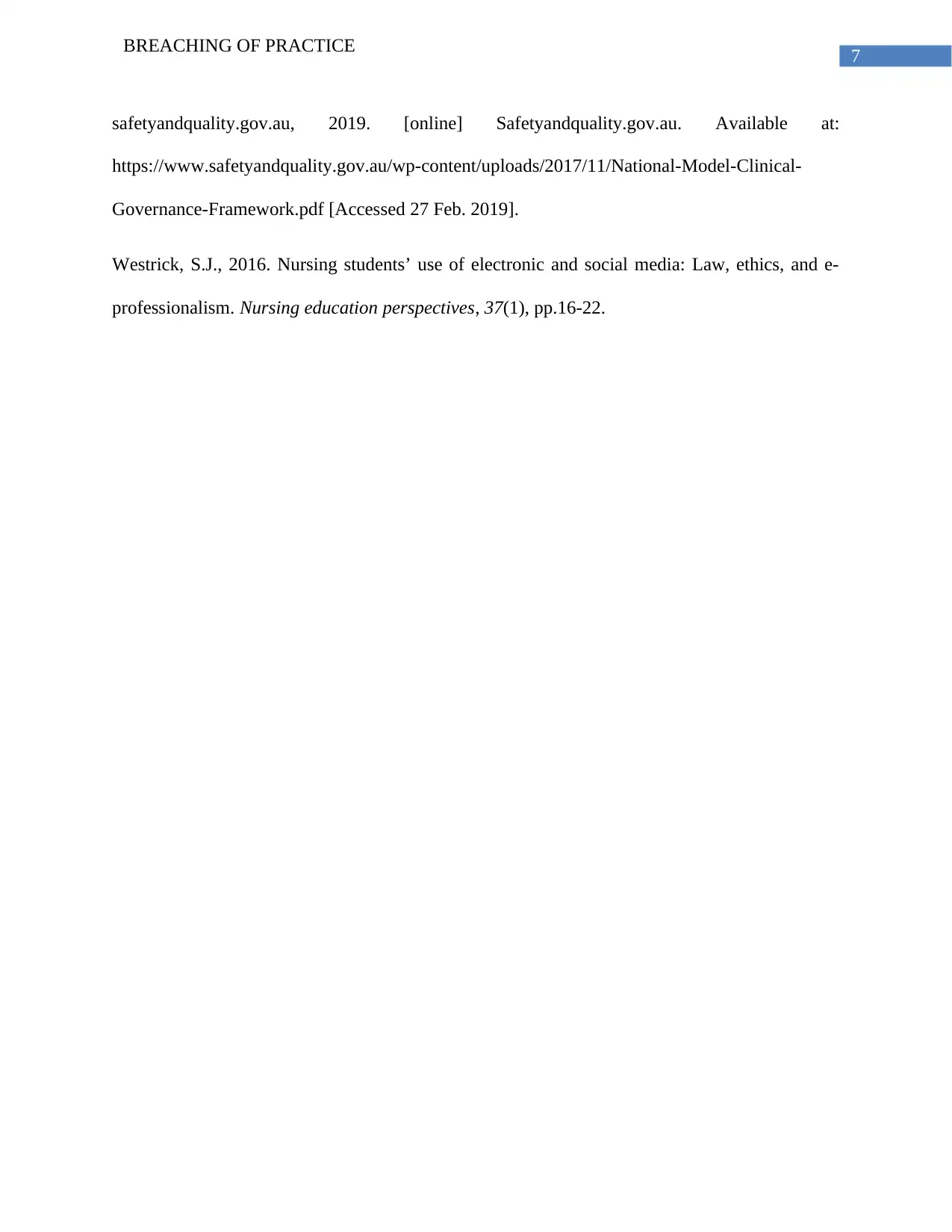
7
BREACHING OF PRACTICE
safetyandquality.gov.au, 2019. [online] Safetyandquality.gov.au. Available at:
https://www.safetyandquality.gov.au/wp-content/uploads/2017/11/National-Model-Clinical-
Governance-Framework.pdf [Accessed 27 Feb. 2019].
Westrick, S.J., 2016. Nursing students’ use of electronic and social media: Law, ethics, and e-
professionalism. Nursing education perspectives, 37(1), pp.16-22.
BREACHING OF PRACTICE
safetyandquality.gov.au, 2019. [online] Safetyandquality.gov.au. Available at:
https://www.safetyandquality.gov.au/wp-content/uploads/2017/11/National-Model-Clinical-
Governance-Framework.pdf [Accessed 27 Feb. 2019].
Westrick, S.J., 2016. Nursing students’ use of electronic and social media: Law, ethics, and e-
professionalism. Nursing education perspectives, 37(1), pp.16-22.
1 out of 8
Related Documents
Your All-in-One AI-Powered Toolkit for Academic Success.
+13062052269
info@desklib.com
Available 24*7 on WhatsApp / Email
![[object Object]](/_next/static/media/star-bottom.7253800d.svg)
Unlock your academic potential
© 2024 | Zucol Services PVT LTD | All rights reserved.





